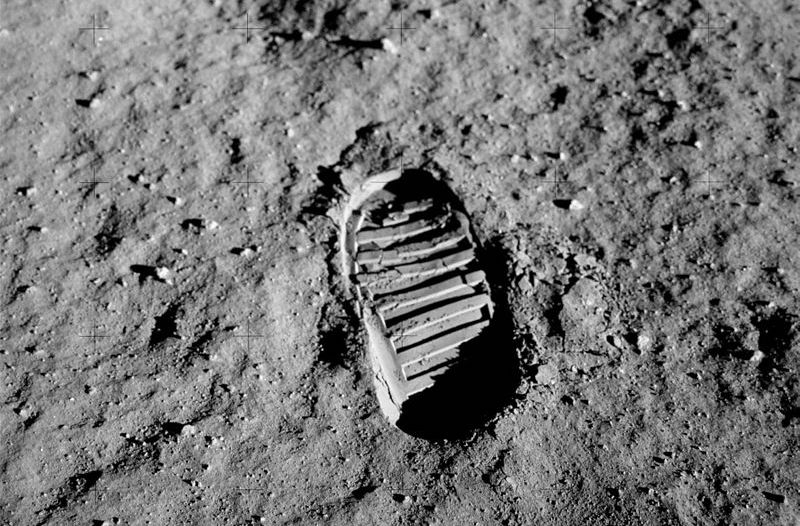Apollo 11 astronaut Buzz Aldrin’s bootprint on the surface of the moon, July 20, 1969. Photo: NASA / Buzz Aldrin
By Salvatore R. Mercogliano – As we celebrate the fiftieth anniversary of mankind’s first steps upon the lunar surface, many have focused their attention to the heavens, but a key component of the success of that first landing on the Moon resides upon the Earth’s oceans with ships crewed by merchant mariners. Many specials are showcasing the career of Astronaut Neil Armstrong who became the first to step upon the Moon on July 20, 1969, as the commander of the Apollo 11 mission. It was on his initial trip to space, as the commander of Gemini 8 in March 1966 that Armstrong, and future Apollo 15 commander, Dave Scott, almost met their fate.
After completing the first successful docking with an Agena target vehicle, the Gemini 8 capsule experienced an ever-increasing role. It was later determined that a static build-up had caused a thruster to malfunction and fire, sending the spacecraft into a tumble. To communicate with their craft, NASA established a chain of communication stations around the world to relay messages to them, since satellite-based systems did not yet exist. While stations on land provided some coverage, the spaceships flew over large tracks of empty ocean, something was needed to track and communicate with them.
In the late 1950s, as the US Air Force began its tests with rockets at Cape Canaveral and the Navy did similar tests on the West Coast of the United States in the early 1960s. Both services procured merchant ships laid up in the reserve fleets of the U.S. Maritime Commission. The Navy handed the ships over to the Military Sea Transportation Service, formed in 1949 to operate merchant ships for the Department of Defense. The Air Force took a different track and contracted with a company directly to operate their range instrumentation ships. In 1957, the U.S. Air Force hired Pan American Airways – yes, Pan AM – to run their ships. This bifurcated process remained in place until 1964 when MSTS took control of all the vessels.
In 1966, as Gemini 8 raced over the Pacific she came into the tracking range of one of the former PanAm ships, USNS Coastal Sentry at station Quebec in the Philippine Sea. In addition to the merchant marine crew, a NASA contingent operated the tracking and communication suite. Sitting at the Capsule Command (Capcom) console, James R. Fucci contacted Gemini 8 for a status and learned of the serious problem facing Armstrong and Scott. It was only by the quick action of Armstrong, shutting down the onboard maneuvering system and activating the re-entry control system (a different set of thrusters) that allowed him to regain control. This forced an immediate abort to the mission. USNS Coastal Sentry, along with Rose Knot, transmitted landing instructions that allowed the craft to land safely in the South China Sea.
Fast forward three years, as Apollo 11 voyaged to the Moon, three specially configured Apollo Instrumentation Ships (AIS) took up station in each of the major oceans of the planet – Atlantic, Pacific, and Indian. The ships had previously served in MSTS as tankers, hauling fuel to military bases in the post-World War Two era. For the Apollo program, the three vessels were taken in hand and completely reconfigured for long-duration operations and to embark teams to maintain contact with the Apollo missions on their flights to and from the Moon. USNS Vanguard, Redstone, and Mercury (named for earlier rocket and manned programs) were essential to provide precise telemetry during the lunar injection phase and the ships needed to be on station for up to 30 days in case of delays in launch.
Two other ships, former Victory-class freighters – USNS Huntsville and Watertown – were also modified for the program. They would provide the tracking and communication for the command capsule Columbia as it returned to Earth and its landing in the Pacific Ocean. Long before this took place, another ship, manned by merchant mariners, the cargo ship dock USNS Point Barrow performed its valuable service.
Point Barrow was built to support Arctic operations during the construction of the Distant Early Warning (DEW) Line in the late 1950s. She was a modified landing ship dock, with a large well deck aft to launch watercraft. For the Apollo program, the tremendous Saturn V rockets were built in California and Louisiana and needed to be transported to Cape Canaveral. With her mission completed in the north, she was fitted with a large hangar over her well and the Saturn Vs were loaded on board her for delivery to the Cape.
As we commemorate the historic events that took place fifty years ago, it is important to remember all those who contributed to the success of Neil Armstrong and Buzz Aldrin walking on the Moon. From the NASA engineers and controllers, to the designers of the millions of components, to those that manufactured and delivered them, and to those merchant mariners who sailed ships that provided that necessary link between the Earth and the Moon half a century ago, the landing was a truly historic and all-encompassing achievement in space, on land, and upon the sea.

 Join The Club
Join The Club











